This is the story about the things we learned making a Hanging Bed. The number one thing we learned, so far, is that these things are not for everybody. The idea of them is interesting in that for some people, the gentle motion reminds them of childhood. The choice of this as furniture is a bit bold, and we say so often, “fate favors the bold.”
Since the time we built this one, which was all the way back in mid 2019, we liked it so much that we built a second one. Both of the upstairs rooms have a “swinging option” now.
Things we learned making a Hanging Bed: The Hanging Bed Decision
Have you seen these things on Pinterest?
It was found out that the equivalent could be bought online for $1500 without ropes or installation.
We actually saw one of these at one point in a shop up in Blue Ridge, and in “spontaneous” fashion, the decision was made to try to make one. We had a conversation the other day about the difference between “spontaneous” and “impulsive” and the line between those two things is very fine.
Since we really didn’t think it would be that complicated, we decided to try it.
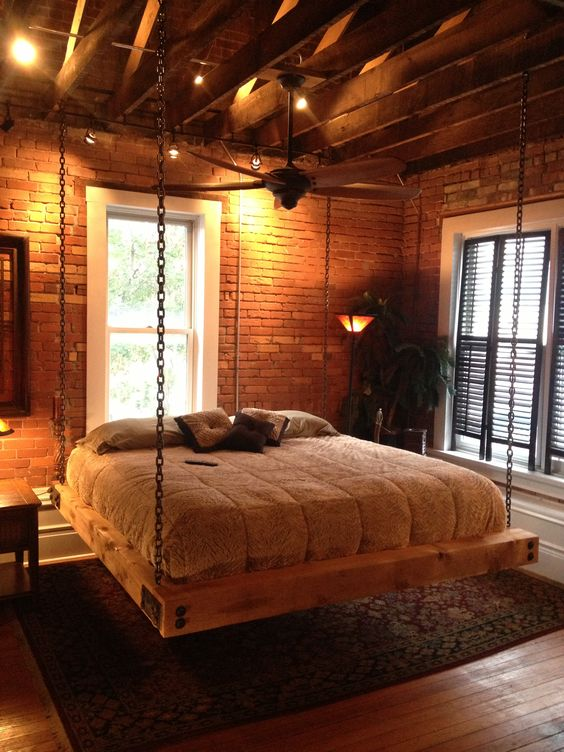
The Bill of Materials
Four 8-foot 4X6 Rough Cut, and a pile of 1X4 12-foot for the slats, from Champion Lumber in Shady Dale. The decision to go to 4X6 was made because Junior had cut a few extra. He gave us the friendly price.
We also got four big eye bolts from TFBBHIS (the famous Big Box home improvement store) for a cost of about $30, and four 10-foot lengths of 1 inch diameter natural fiber rope was ours for a total of about $50. So the total all-in cost of the materials was something on the order of $140. IF you are keeping track, this is 1/10 of the amount of the store-bought version. We got the Overstock mattresses.
Initial Cutting and Assembly
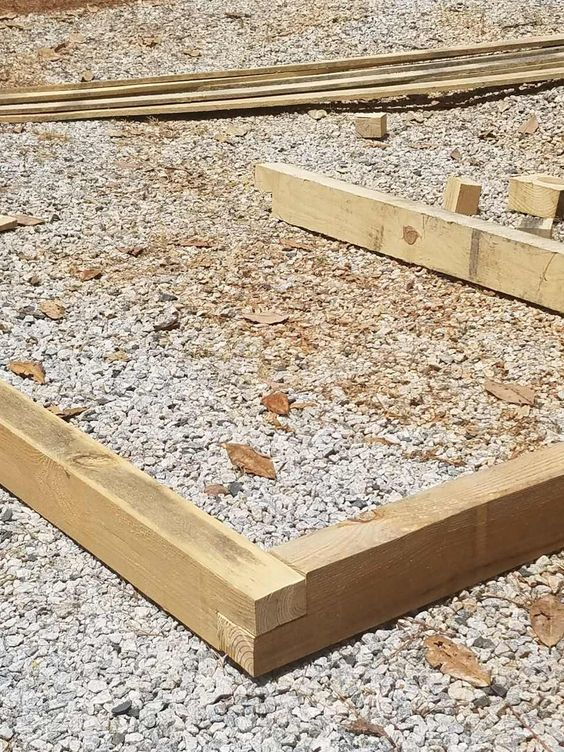
The inside opening is 80 by 60, which is what a queen size bed is. Therefore the cuts were made 68 and 88 inches. If you really care about how we did the cutting click us back and we will lay it all out to you. That was the first learning, which was how we were going to make the corners.
The second learning was that the rough cut lumber is irregular. There was as much as 1/4 inch variation in thickness in one piece from one end to the other. We typically do not let things like that bother us. The bed was declared “rustic” and “close enough”. We made a shim in the one case where the difference was too great and we needed the corner to be flush
The third learning was that it is hard to cut halfway, but no more than halfway, through a big piece of wood with the saws that were available. The 7 1/4 inch circular saw and a big slasher saw with a wood blade became the tools of choice.
The Firefly Style
Do you remember the Woodwright Shop on PBS for the last 37 years? He has been using primitive hand tools to hack out furniture in various traditional styles. Well, if he tries to duplicate this particular piece of brilliance in the year 2058, he is going to be in for a surprise. It was through patience and dangerous operation of inappropriate hand tools that this project was accomplished. All we can say is, that it is true to the Firefly tradition: cheap, indestructible, and made in a hell of a hurry with a minimum of proper tools.
The 7 things we learned making a Hanging Bed did include a lesson in lumber cutting.
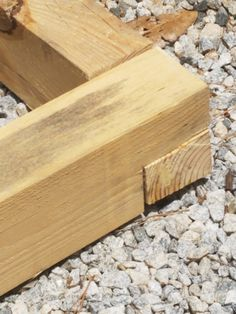
Case in point was the drilling. The corners are six inches thick. Our one inch drill bit was five inches long. The corners had to be drilled through as far as possible, disassembled, and finished off in pieces. That is a common strategy at this place.
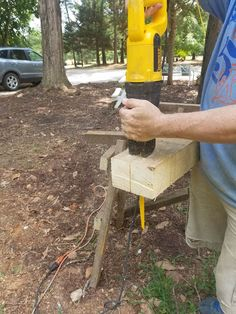
Assembly
Not all that hard, compared to coming up with the idea. The tricky part was the hangers. One of the things we learned making a Hanging Bed is that it is not all complicated.
The Hangers
We used 2X4 stacked on each other for each corner, and big eye bolts that a one-inch rope can go through. That was the fifth learning, that this would work.
The lag bolts basically do the job of holding these things in place. The downward force of the bed is borne by the ends of the hangers and of course the rafters. The rafters in this place, by the way, don’t actually support any weight. Their job is to hold the walls up to counteract the force of the A-Frame.
One of the other things we found out is that if you don’t have the ropes perfectly straight, this thing will swing crookedly, and we don’t want that. So, in both of the cases, we went through a lot of time and effort and several re-dos to make sure they would hang straight.
Engineering Stuff
Sixth Learning: When a piece of wood breaks, it does so because it exceeds the amount it can be deformed by the force exerted on it. So, the hangers we made close to the end of the rafters, where they are held up by the wall, will be the strongest. In theory they will deform the least. The weaker hangers will be where they are attached to the middle of the rafters, because they will deform the most.
According to the paper referenced below, the breaking strength of a 2X4 8-foot is more than 1500 pounds if bent the thin way. the rafters are 2X6 and sitting the long way. These little 16-inch pieces will deform less than a full sized 2X4 so they’ll be even stronger. So, the ceiling rafters and hangers should hold this all no problem.
The pull-out force for a lag bolt in southern pine is over 400 pounds. We could have done this project with lag screws. An eye bolt, with washers on both ends is going to be higher than that.
How Much does it Weigh?
The railings weigh something like 75 pounds apiece, so 300 pounds for the frame. Another 100 pounds for the slats, and 68 pounds for the mattress. 400 pounds for the three drunk naked sorority girls who will be standing on this rocking back and forth singing Purple Rain at some point. The total weight for the whole thing in service might be 868 pounds, give or take.
The ropes themselves have a breaking strength of 560 pounds, according to the box, although this was in new condition. If they get frayed, it will be less, so they will have to be monitored and replaced occasionally.
The four hangers are supported at two points each. That’s 8 points of contact or only about 106 pounds apiece. So force wise, fully occupied, this thing should be fine. If additional stresses are added due to extra swinging, for example, that calculation would have to be made. The ropes and the eye bolts should be more than twice as strong as they need to be.
Wood is pretty strong in compression like that.
The Knots
Under the corner where the rope goes through the frame, a regular knot. In the hangers, something that is apparently called a “double half hitch”. It won’t slip out. We did check the level, which was fine. We did find out after about six months that one of the knots had slipped a bit, causing an issue of levelness, but it was easy enough to fix.
ps: If this were nylon rope, which was cheaper, it would be weaker, and more importantly be much less friendly for knots.
The seventh learning: Boy scout training sometimes amounts to something eventually.
Customer Acceptance of the Hanging Bed
Pretty good, we think. What we did find out is that over a period of time, the ropes stretched, and this thing got closer to the floor than the original 14 inches. When we built the second one, it was a little heavier still, and is already close to the floor.
The room with the original swinging bed, which we call the Nest, is the most popular room we have. Most people try the swinging for one night, and then ask for the non-swinging option the second night.
At one point, this thing was duplicated in the Treehouse and to tell the truth, the place has had so many visitors that we haven’t gotten around to taking a good photo. If we can find some more, we will put them in.
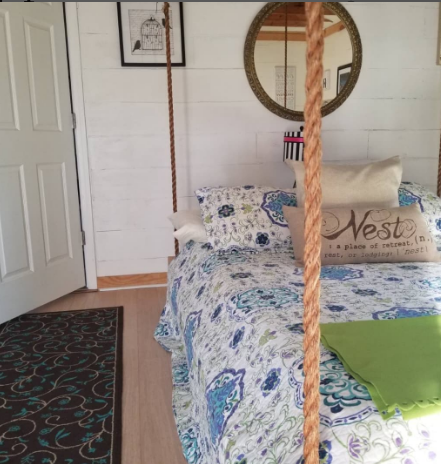
A couple of other fun things have happened since the original bed was constructed in 2019, the biggest one of which is that we put all new bamboo flooring in these rooms, and they really do look like the picture of the $2,000 ones in the photos above, if we turn on the lights just right. We will get another picture at some point.
Do Over
If we had to do this over again, would we? We spent a lot of time awhile back on the concept of being “remarkable.” We’re never going to be as “remarkable” in the same way as Twelve Oaks, but everyone that stays here has a little interesting story about the swing bed, and that is a good thing. Most of the people that stay here can get into the spirit of it, the way it is intended.
We’ve got a lot to say about Human-Scale Living, and this is an example. We are makers, on a good day.
Either way we got a couple of seemingly expensive beds for the “friendly price” plus a little work.
So not only would we do it over again, we did.
Further Thought Question
If you wanted to order one of these things online, could you? Even if you did, is there a way to pay one of the local contractors to install it? There is some irony in here somewhere as well.
Here it is: I will link it below. Note the price inflation, once you add the ropes and hardware, and you still haven’t paid some local contractor to hang it.


Links and References
Pull Out Weight of Eye Bolts
https://www.zillarac.com/Portals/0/Documents/PDF/Screw%20Pull-out.pdf
How does wood break?
https://www.fpl.fs.fed.us/documnts/fplrp/fplrp64.pdf
The Woodwright Shop
https://www.pbs.org/woodwrightsshop/watch-on-line/watch-season-episodes/2012-2013-episodes/
Porch Swing Store
![]()
